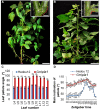GmILPA1, Encoding an APC8-like Protein, Controls Leaf Petiole Angle in Soybean
- PMID: 28336772
- PMCID: PMC5462013
- DOI: 10.1104/pp.16.00074
GmILPA1, Encoding an APC8-like Protein, Controls Leaf Petiole Angle in Soybean
Abstract
Leaf petiole angle (LPA) is an important plant architectural trait that affects canopy coverage, photosynthetic efficiency, and ultimately productivity in many legume crops. However, the genetic basis underlying this trait remains unclear. Here, we report the identification, isolation, and functional characterization of Glycine max Increased Leaf Petiole Angle1 (GmILPA1), a gene encoding an APC8-like protein, which is a subunit of the anaphase-promoting complex/cyclosome in soybean (Glycine max). A gamma ray-induced deletion of a fragment involving the fourth exon of GmILPA1 and its flanking sequences led to extension of the third exon and formation of, to our knowledge, a novel 3'UTR from intronic and intergenic sequences. Such changes are responsible for enlarged LPAs that are associated with reduced motor cell proliferation in the Gmilpa1 mutant. GmILPA1 is mainly expressed in the basal cells of leaf primordia and appears to function by promoting cell growth and division of the pulvinus that is critical for its establishment. GmILPA1 directly interacts with GmAPC13a as part of the putative anaphase-promoting complex. GmILPA1 exhibits variable expression levels among varieties with different degrees of LPAs, and expression levels are correlated with the degrees of the LPAs. Together, these observations revealed a genetic mechanism modulating the plant petiole angle that could pave the way for modifying soybean plant architecture with optimized petiole angles for enhanced yield potential.
© 2017 American Society of Plant Biologists. All Rights Reserved.
Figures






Similar articles
-
UV-B irradiation-activated E3 ligase GmILPA1 modulates gibberellin catabolism to increase plant height in soybean.Nat Commun. 2023 Oct 7;14(1):6262. doi: 10.1038/s41467-023-41824-3. Nat Commun. 2023. PMID: 37805547 Free PMC article.
-
Dysfunction of an Anaphase-Promoting Complex Subunit 8 Homolog Leads to Super-Short Petioles and Enlarged Petiole Angles in Soybean.Int J Mol Sci. 2023 Jul 3;24(13):11024. doi: 10.3390/ijms241311024. Int J Mol Sci. 2023. PMID: 37446203 Free PMC article.
-
GhAPC8 regulates leaf blade angle by modulating multiple hormones in cotton (Gossypium hirsutum L.).Int J Biol Macromol. 2022 Jan 15;195:217-228. doi: 10.1016/j.ijbiomac.2021.11.205. Epub 2021 Dec 9. Int J Biol Macromol. 2022. PMID: 34896470
-
Identification and functional characterization of a leucine-rich repeat receptor-like kinase gene that is involved in regulation of soybean leaf senescence.Plant Mol Biol. 2006 Aug;61(6):829-44. doi: 10.1007/s11103-006-0052-5. Plant Mol Biol. 2006. PMID: 16927199
-
Molecular and genetic basis of plant architecture in soybean.Front Plant Sci. 2024 Oct 7;15:1477616. doi: 10.3389/fpls.2024.1477616. eCollection 2024. Front Plant Sci. 2024. PMID: 39435023 Free PMC article. Review.
Cited by
-
CRISPR/Cas9-mediated targeted mutagenesis of GmSPL9 genes alters plant architecture in soybean.BMC Plant Biol. 2019 Apr 8;19(1):131. doi: 10.1186/s12870-019-1746-6. BMC Plant Biol. 2019. PMID: 30961525 Free PMC article.
-
The Arabidopsis anaphase-promoting complex/cyclosome subunit 8 is required for male meiosis.New Phytol. 2019 Oct;224(1):229-241. doi: 10.1111/nph.16014. Epub 2019 Jul 24. New Phytol. 2019. PMID: 31230348 Free PMC article.
-
The F-box protein MIO1/SLB1 regulates organ size and leaf movement in Medicago truncatula.J Exp Bot. 2021 Apr 2;72(8):2995-3011. doi: 10.1093/jxb/erab033. J Exp Bot. 2021. PMID: 33506247 Free PMC article.
-
LRM3 positively regulates stem lodging resistance by degradating MYB6 transcriptional repressor in soybean.Plant Biotechnol J. 2025 Jul;23(7):2978-2993. doi: 10.1111/pbi.70124. Epub 2025 May 7. Plant Biotechnol J. 2025. PMID: 40333576 Free PMC article.
-
Mining Candidate Genes for Leaf Angle in Brassica napus L. by Combining QTL Mapping and RNA Sequencing Analysis.Int J Mol Sci. 2024 Aug 28;25(17):9325. doi: 10.3390/ijms25179325. Int J Mol Sci. 2024. PMID: 39273273 Free PMC article.
References
-
- Cheng W, Gao JS, Feng XX, Shao Q, Yang SX, Feng XZ (2016) Characterization of dwarf mutants and molecular mapping of a dwarf locus in soybean. J Integr Agric 15: 60345–60347
-
- Clough SJ, Bent AF (1998) Floral dip: a simplified method for Agrobacterium-mediated transformation of Arabidopsis thaliana. Plant J 16: 735–743 - PubMed
MeSH terms
Substances
LinkOut - more resources
Full Text Sources
Other Literature Sources
Miscellaneous

